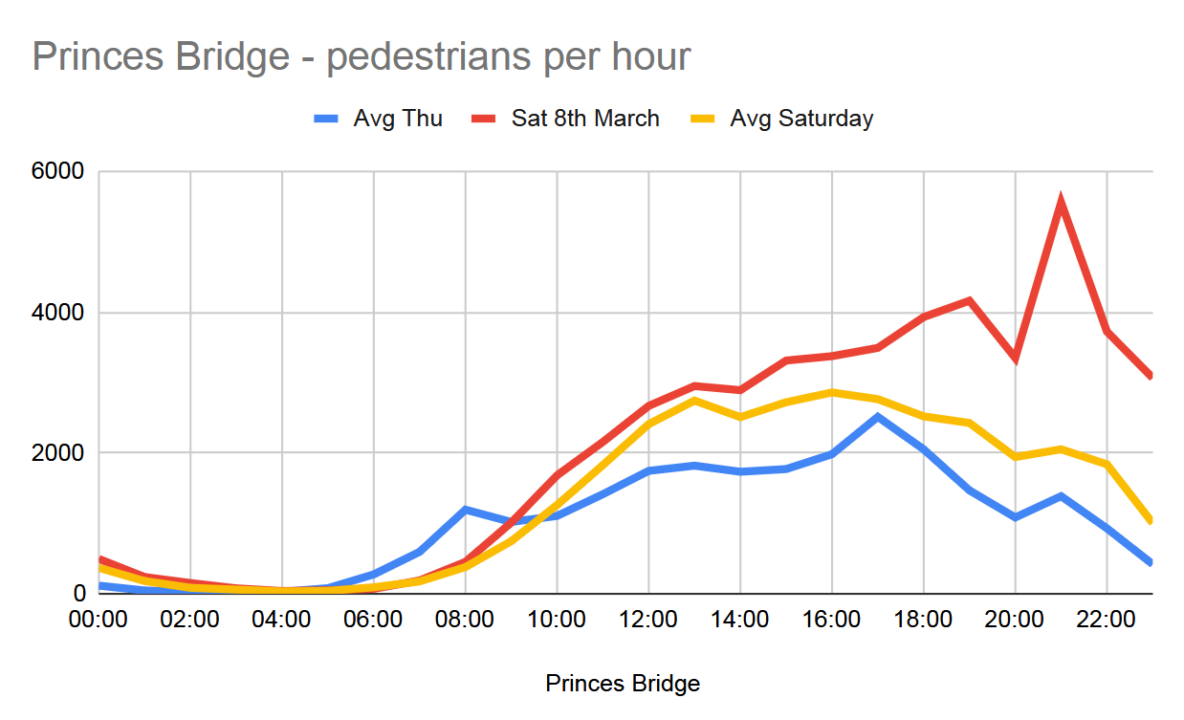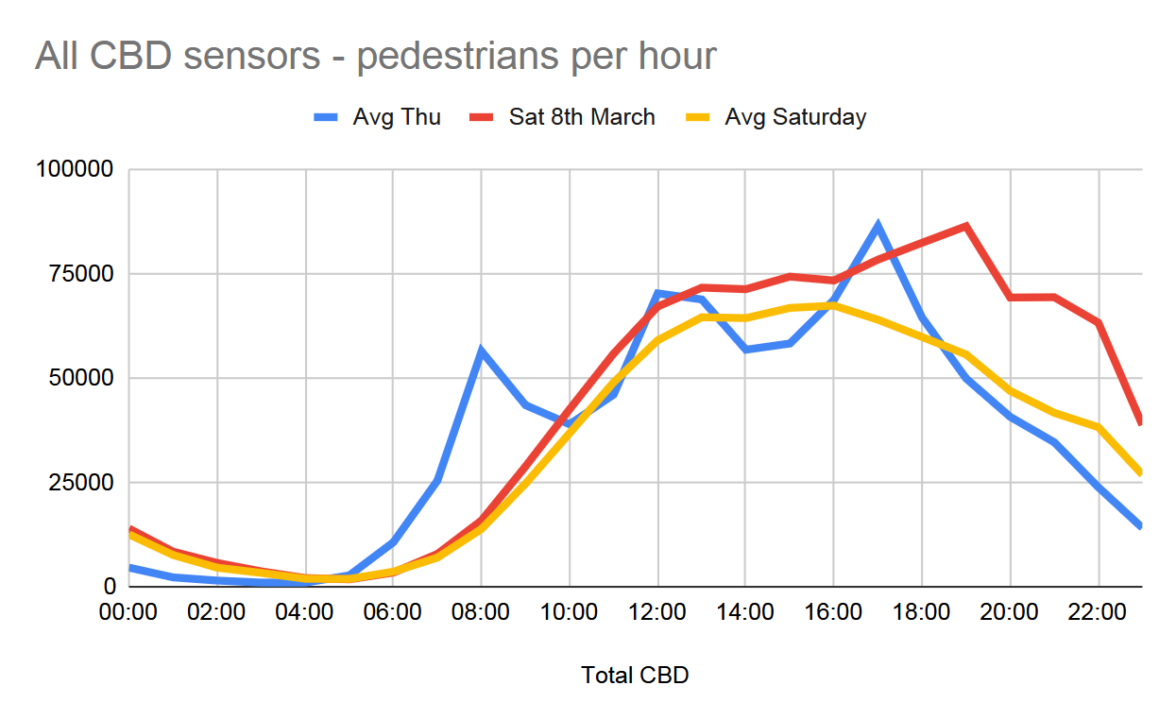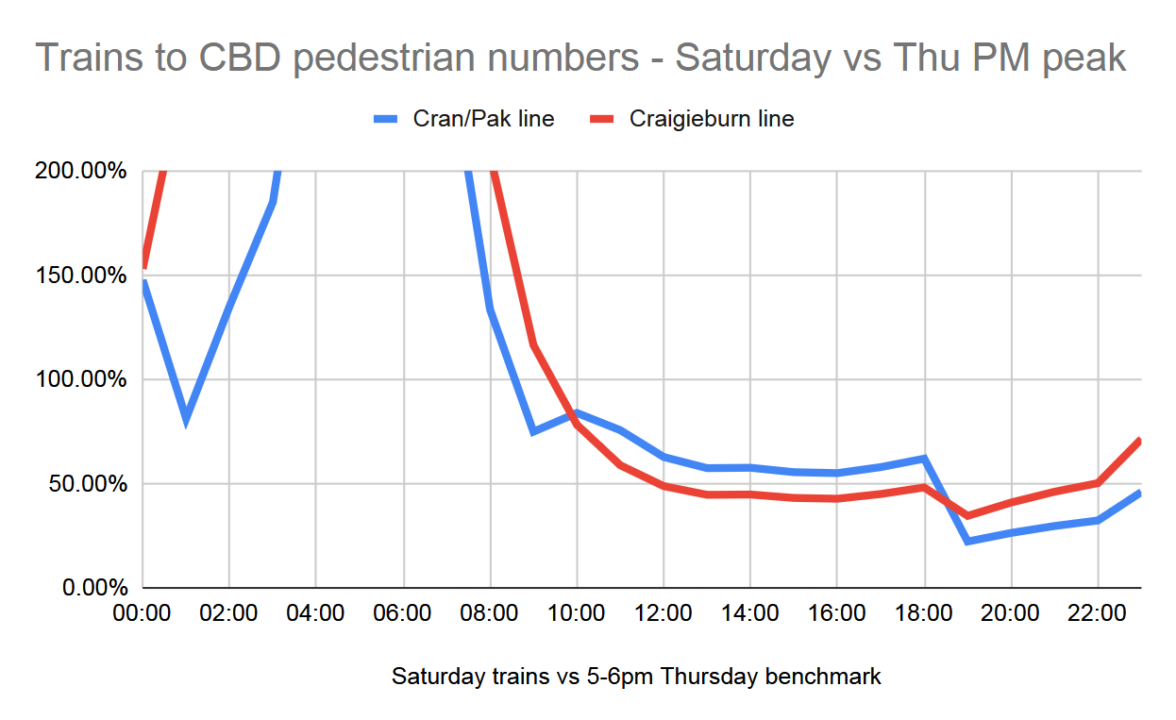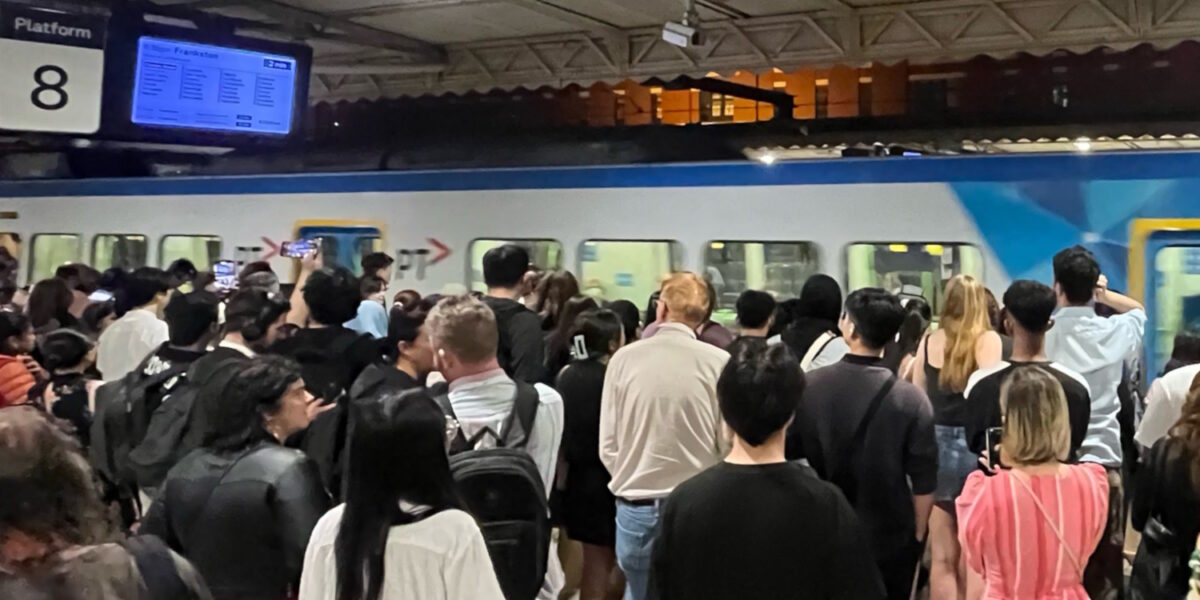Last weekend was the the Labour Day long weekend, with the Moomba festival in central Melbourne, and huge crowds in part thanks to warm weather.
The City of Melbourne said crowd numbers across the event were expected to break records, with up to 1.3 million people in attendance.
But Moomba wasn’t the only event in town last weekend.
Other events in central Melbourne on Saturday 8th March included:
- Billie Eilish at Rod Laver (about 14000 people)
- A-League at AAMI Park (attendance 8206)
- New Order at Sidney Myer Music Bowl (capacity 12000)
- Cruel Sea and others at a concert in the Royal Botanic Gardens
- Any number of smaller concerts and events were on around the CBD, including at The Forum and Crown
On this Saturday, there were no extra public transport services scheduled, aside from five extra trains around 10pm after the A-League match. Those started from Richmond, so were unable to provide any extra relief for other events – despite official claims of “plenty of tram, train and bus options”.
(Just 2 Likes? Why on earth are they posting this info to Twitter and nowhere else? Are they obvious to the exodus?)
The problem of no extra public transport services on a busy Saturday night? Regular evening train timetables are insufficient, with trains only every half hour on most lines (all but three), including the really busy lines like Cranbourne/Pakenham.
It’s an issue of both capacity and waiting time. You want everyone to fit on board, but you also want them not to have to wait 30 minutes for a train home after a big night out. Treat people like that too many times and they’ll stop using your service, and drive instead.
You won’t be surprised to hear that many trains were packed. One concert-goer noted queues just to enter Flinders Street station, and said it was as busy as peak hour.
How busy: Princes Bridge
So how busy was the City on Saturday?
City of Melbourne’s pedestrian counter system provides good data on the number of people passing fixed positions around the CBD.
Looking at the Princes Bridge sensor, which is just south of Flinders Street station on the busier western side of the bridge, we can see that from about 10am, average Saturdays (orange line) are busier than average Thursdays (blue line), and that Saturday 8th March specifically (red line) was far busier still.

Work days being quieter than Saturdays on Princes Bridge isn’t unexpected given the vast majority of workplaces near the station are in the opposite direction to this sensor.
Saturday 8th March had a big spike in the 9-10pm hour, with many Moomba activities finishing at 9pm, and the nightly fireworks ending a few minutes later.
But even after that, with the concerts ending after 10pm, there were more people walking past until midnight than in the busiest hour on an average Thursday or Saturday.
How busy: CBD
If we add up sensor readings from all over the CBD, we can see how busy the rest of central Melbourne was.
Note: this is not measuring the number of people. Not everybody walked past a sensor each hour, and conversely some people would have walked past more than one sensor. We’ll just use this to compare the relative pedestrian traffic at the times shown.

The average Thursday (blue line) has a peak during the morning commute 8-9am, another at lunchtime, and a third in the evening peak 5-6pm.
The average Saturday (orange line) is smoother and less spiky than a Thursday, but busier after 7pm.
On Saturday 8th (red line) the CBD was busier than the average Thursday or Saturday after 1pm, except the Thursday commuter peak.
In fact the commuter peak at Thursday 5-6pm is the busiest single hour in the CBD all week. Let’s focus on that, and compare it to Saturday 8th March.
- Saturday the 8th, 7-8pm was as busy as the Thursday evening peak.
- In the hour of 10-11pm, when many of the concerts were finishing up, it was about 73% as busy as Thursday evening peak.
- Even on the average Saturday, 10-11pm is about 44% of Thursday 5pm-6pm. Obviously quieter than the 8th, but still pretty busy.
How many trains?
So my question is: if Melbourne is increasingly busy on weekends and in the evenings, is public transport provision keeping up?
If the CBD is at its busiest on Thursdays 5-6pm, when quite rightly the train service frequency also peaks with frequent service on most lines, how do Saturday services stack up?
The answer is not very well.
Let’s look at two busy lines: the Craigieburn line to the north, and the longer Cranbourne/Pakenham line to the southeast.
If we treat Thursday 5-6pm as the benchmark in terms of train services per pedestrian movements, here’s how each hour looks on the average Saturday.

Overnight and early morning looks like over-supply, but remember this is only measuring capacity. You need a minimum service frequency to provide a service that anybody can use. I’ve cropped the top of the scale so we can focus on mid-late morning, afternoon and evening.
From 9am for the rest of the average Saturday, train services on these two lines fall below the benchmark, in other words total capacity is low compared to peak hours, relative to the number of people moving in and around the CBD.
Not that everybody’s making a trip that could be on a train – particularly in daytime, many people would be walking around exploring, shopping, and so on.
From 7pm – when you’d expect more people are heading home – the capacity drops even lower.
- Craigieburn drops from 3 trains per hour to 2
- Cranbourne/Pakenham drops from 6 trains per hour to 2
In the 7-8pm hour the capacity relative pedestrian movements, compared to the peak service is just 34% on the Craigieburn line, and 22% on the Cran/Pak line.
It rises slightly as the city quietens down, but is still well below the benchmark in the 11pm-midnight hour.
Lack of weekend service isn’t just a Melbourne CBD problem; it’s also an issue across the rest of the urban area.
This is a very simplistic calculation, and only based on two lines, and pedestrian activity that doesn’t exactly match potential train passengers.
But what it shows it reflects the experience of train passengers last Saturday night. Even after waiting up to 30 minutes for a train home, many people couldn’t get a seat for the ride home.
And more broadly, the fact that travel patterns have changed has been repeatedly flagged – including recently in The Age, with the management of Melbourne Central shopping centre reporting a notable shift to weekend shopping, and “We’re at record number of sales coming out of Melbourne Central.”
Extra services for specific events are really a side issue. Melbourne is busy every weekend. The problem is the suburban rail network’s base level of service – which mostly hasn’t changed in 50 years, particularly on Saturdays – is too low.
More people are travelling on weekends. Why isn’t Melbourne’s public transport service adapting?
Sunday pedestrian counts are a bit different to Saturdays, especially in the evening, and some train services are much reduced in the mornings. I might do a follow-up post on that.
Thankfully there is movement in regional Victoria from next month, with V/Line’s Ballarat line moving to every 40 minutes and PTV noting upgraded regional bus services.



21 replies on “Weekend trains not keeping up”
And then you add planned works, a couple of weeks ago I and my partner courted a train to Southern Cross and was planning to South Yarra to see a play at Chapel off Chapel and to discover no trains for Frankston, Cranbourne, Pakenham and Sandringham, replacement buses are coaches and I am in a wheelchair. Far from happy, why do planned works happen on weekends, they should be at night.
Sydney has 15 minute weekend train frequencies from first to last, and evening trains are well used, despite all these factors going against them:
– 2 person train crews, so services are expensive to operate
– Lack of nightlife and fewer events (often spread out to places like Olympic Park) in the Sydney CBD meaning it’s a far less popular evening destination than the Melbourne CBD
– Predominant morning culture in Sydney, compared to Melbourne which has a predominant evening culture
It’s almost like the two cities should swap train timetables, because Melbourne has the nightlife and needs a frequent service, and Sydney has a frequent service but lacks things happening in the evening.
The only thing aside from public transport which hasn’t changed in over fifty years is Spring Street. Force the Old Boys (all from elite private schools) and for-profit politicians out of parliament and allow new blood to take over for the first time in almost a century (or about the second time since Federation).
The Greens’ biggest blocker is that triangular logo that looks like a green version of the ⚠️ hazard sign e.g. “avoid”. If their name was Labour (with a u) or Progressives or something like that they probably would have been in government by now.
I suppose the simple answer is that extra services cost money. If fare evasion was better policed, there may be money to improve services. Spend some money on fighting fare evasion, fines will roll in, and probably be profitable for the government.
Yarra Trams will praise itself for the Grand Prix service it provided, and it does do a good job at that, although to the disadvantage of regular passengers. There are frequent summer events in St Kilda, and Yarra Trams caters for the event, but not the aftermath, when there are still hundreds of people who need trams It is the same for Pride March and various other events. Yarra Trams, well PTV, the government department, can cater for special events and but not for passenger demand.
I was looking at 1995 tram timetable today for route 72. I had forgotten how bad the Sunday service was, 30 minutes until 1pm on Sundays, and then a 20 minute to around 6pm, then back to 30 minutes. There has been some improvements.
Metro Trains need to move to Bluesky and Mastodon, or at the very least run a clone bot that just copies their post on Twitter.
Also I hope once ANZAC station opens, the Grand Prix trams can just run as regular service trams that has enhanced frequencies to handle the extra crowd.
Trams were not much better. On the Friday, I got a sardine route 16 towards St Kilda about 8PM, and when we got to St Kilda junction, the driver lets the still packed tram know that it was suddenly becoming a route 3 tram. I quickly checked the real time info and it looked like the next route 16 was 15+ minutes away (unless they were going to change another tram behind us to become a route 16), so I stayed on and had a slightly longer walk at my stop. Most people got off the tram thinking they wouldn’t have to wait long but probably did…
The night after, I got a sardine route 6 from said New Order concert and of course they were running a high floor low capacity tram rather than a D2.
In a parallel universe out there with functional bureaucrats and politicians, Melbourne runs trains, trams and orbital bus routes every ten minutes from 6 AM till 10 PM.
There are no timetables, just the expectation of frequent, reliable public transport. Fares are high enough to cover at least some running costs but people don’t mind because service is so good.
@Jim. Steady on there about Sydney! We have lines closed for weekend trackworks as well as, on the suburban system, regular system-wide catastrophic collapses, after which it takes a day to get everything back together, largely due to getting those two-person crews back on the job. Melbourne must have better redundancy to avoid those situations. Sydney Metro doesn’t have those problems but still has occasional weekend closures.
Are there any pedestrian counters inside CBD stations? and are they publicly available?
Clearly the government doesn’t read blogs or care about PT, as the same topic was covered one-and-a-half years ago:
https://danielbowen.com/2023/09/16/pt-services-vs-travel-demand/
The only PT winner in all that time was the 800 bus, and only following a mammoth campaign. If only there was a #FixSmartBus campaign to go with it, as the SmartBus network is well and truly hopeless on the weekend (907 aside), with blanket half-hourly services all day, sparse (and hourly) Night Network coverage with only half of the routes running despite massive gaps in the network (902 on Springvale Rd, both the 901 and 906 on Blackburn Rd, the 903 on Warrigal/Elgar Rd, all three orbitals through the northern suburbs), and no Sunday evening services (the 703 doesn’t run on public holiday evenings either and has an 85-minute gap on Friday nights between the last normal service and Night Network).
@Andrew Cee: Public transport never returns a profit as no-one would use it; for PT to just break even the public would have to pay around $40 per trip, which makes taxis look cheap. Also, the stick approach to revenue protection isn’t working, anyone who has been harassed and/or had their pockets emptied unfairly by the myki mafia (e.g. due to faulty myki validators or having nowhere to top up along 95% of a tram/bus route e.g. 75 tram or 906 bus) have got back in their cars and vowed never to use PT again.
The complete and utter uselessness of buses due to often being once an hour and only during daylight hours and/or not running on Sundays and public holidays just adds insult to injury. Add to that slow and late trams that are stuck in traffic and have poor traffic light priority, the train network breaking down all the time, and trains themselves being slow (particularly with the Burnley and Clifton Hill groups where there are way too many inner-city stations, namely Darebin, Dennis, Ruthven, Croxton, Rushall, Collingwood (not footy bias – VP and NR are better located), West Richmond, Willison, East Camberwell, Auburn and East Richmond) and infrequent (every 20, 30, 40 and even 60 minutes off-peak is anything but “metro”).
All senior executives in the Department of Transport and Planning and all members of state cabinet should be required to attend an evening sporting or cultural event in the CBD once a month and use only public transport to travel to and from.
At present, public transport is often not a convenient, let alone enticing, option – especially for families.
Melbourne could be doing so much better with its existing infrastructure.
Perth provides an example of one small innovation – tickets for any event at Optus Stadium entitle the ticketholder to free train travel to the stadium.
@Tim. Sydney has a similar system with major events – fares included in entry price. I thought Melbourne did too? In Perth you can only get to Optus Stadium by public transport, taxi or walking. They deliberately provided no car parking. Best public trasnport incentive in Australia!
Do weekend trains turn a profit (or make a similar loss to weekday services)?
Assuming there’s similar loading to week days does the $5.50 per passenger cover the increased cost of driver penalty rates/overtime?
Perhaps this is the reluctance for the government to increase services. If weekend costs are significantly higher (and considered less essential for business) it might be being intentionally ignored…
Thanks for sharing your insights again Daniel. It is frustrating when many times the State Government has been made aware of infrequent and overcrowded weekend train (and tram services in the evening). There are events on basically every weekend in Melbourne and 20 minute day time and 30 minute evening frequencies (or worse) are not acceptable for a large and growing major city.
Hoping when the Metro Tunnel opens we finally get a frequency boost, ideally with services running at least every 15 minutes on all lines from 7am to midnight, and maybe every 20 minutes on quieter single track sections such as the Altona Loop, beyond Eltham etc. Just like Sydney’s frequency and would help support Melbourne’s event industry and help reduce traffic congestion, making train travel more attractive to the city, rather than driving due to reduced wait times for services.
Thanks for sharing your insights again Daniel. It is frustrating when many times the State Government has been made aware of infrequent and overcrowded weekend train (and tram services in the evening). There are events on basically every weekend in Melbourne and 20 minute day time and 30 minute evening frequencies (or worse) are not acceptable for a large and growing major city.
Hoping when the Metro Tunnel opens we finally get a frequency boost, ideally with services running at least every 15 minutes on all lines from 7am to midnight every day, and maybe every 20 minutes on quieter single track sections such as the Altona Loop, beyond Eltham etc. Just like Sydney’s frequency and would help support Melbourne’s event industry and help reduce traffic congestion, making train travel more attractive to the city, rather than driving due to reduced wait times for services.
We now have AFL matches on Thursday nights and some concerts throughout weekdays so services ideally should be at least every 15 minutes until midnight everyday.
Argh, so busy at the moment, has been difficult to find time to respond to comments.
@David, alas some works take more than a night… or if they were confined to night, they’d take ages. They definitely need to do better at bus replacements though.
@Andrew Cee, yes Sunday trams improved in 1999 when Sunday trains went from mostly every 40 mins to mostly 20.
It’s a shame Sunday night trams remain at 30 though.
@Nick, so your tram effectively bypassed St Kilda Beach? I wonder if it continued to Kew or went to East Malvern?
@Robert, I’m not aware of any counters inside stations, at least not any with published data.
@Tim/@Tony, it’s possible in Melbourne to organise integrated ticketing. Not many events do it.
https://www.ptv.vic.gov.au/footer/about-ptv/event-information/special-event-and-conference-tickets/
@Stirling, it’s very difficult to work out which individual services turn a profit, and whether people will use them or not is a product of the overall network offering. The attractiveness of peak hour services for everyday commuting is not just about those services; it’s partly also knowing off-peak and evening services exist so you know you can get home if you work a half day or go out to dinner and a show after work.
As a rule, transport systems (road, rail, whatever) don’t make money. They provide wider benefits and keep our cities functioning.
But I take your point. Extra services cost money. Showing the benefit of it is important.
@Anonymous, yes we can hope there’s a big service boost tied to the Metro tunnel. There has been a trend to move to 10/20 frequencies (rather than 15/20) to ensure compatibility of paths where routes share tracks.
A few lines such as Frankston now run 10 mins most of the time, 20 in the evenings – a vast improvement, but this is needed on more of the network.
I seriously would love to live in London, sometimes. We walked out of the Easter vigil Mass at nearly midnight in the middle of London (in 2023), strolled into Victoria station, hopped on the Tube, then changed to a bus, which was still running frequently at that hour, and were back home (23 km away) in an hour. In Melbourne it would be a walk at that time.
Network frequencies have not kept up with demand for decades. Articles like this similarly have been written for decades. How do we get the government to actually take action here?
Caught a Mernda train the week before Easter Sunday (city bound, reaching Southern Cross about 10 am) which filled to crush capacity after reservoir, yet the service interval at that time was 40 minutes. Why do they treat weekend morning passengers so badly?
[…] and travel demand has changed and is no longer focused on the traditional commuter peaks. There is more travel on the weekends and in the […]